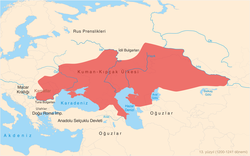Người Kipchak
Giao diện

Người Kipchak hay Qipchak, còn được gọi là người Turk Kipchak hoặc người Polovtsia, là một dân tộc và liên minh du mục người Turk tồn tại từ thời Trung cổ, sinh sống ở các vùng của thảo nguyên Á-Âu. Được đề cập lần đầu tiên vào thế kỷ thứ VIII với tư cách là một phần của Hãn quốc Hậu Đột Quyết, rất có thể họ sinh sống ở vùng Núi Altai, từ đó họ mở rộng lãnh thổ trong các thế kỷ tiếp theo, đầu tiên là một phần của Hãn quốc Kimek và sau đó là một phần của liên minh với người Cuman. Có những nhóm người Kipchak ở thảo nguyên Pontic–Caspi, Trung Quốc, Syr Darya và Siberia. Liên minh Cuman–Kipchak bị người Mông Cổ chinh phục vào đầu thế kỷ XIII.
Chú thích
[sửa | sửa mã nguồn]Tham khảo
[sửa | sửa mã nguồn]Nguồn
[sửa | sửa mã nguồn]- Agajanov, S. G. (1992). “The States of the Oghuz, the Kimek and the Kipchak”. History of Civilizations of Central Asia, Volume IV: The Age of Achievement AD 750 to the End of the Fifteenth Century. Motilal Banarsidass. tr. 61–76. ISBN 978-81-208-1595-7.
- Damgaard, P. B.; và đồng nghiệp (9 tháng 5 năm 2018). “137 ancient human genomes from across the Eurasian steppes”. Nature. Nature Research. 557 (7705): 369–373. Bibcode:2018Natur.557..369D. doi:10.1038/s41586-018-0094-2. hdl:1887/3202709. PMID 29743675. S2CID 13670282. Truy cập ngày 11 tháng 4 năm 2020.
- Ergin, Muharrem (1980). Orhun Abideleri (bằng tiếng Thổ Nhĩ Kỳ). İstanbul: Boğaziçi Yayınları.
- Golden, Peter B. (1990). “The peoples of the south Russian steppes”. Trong Sinor, Denis (biên tập). The Cambridge History of Early Inner Asia. Cambridge University Press. tr. 256–284. ISBN 978-0-521-24304-9.
- Golden, Peter B. (1992). An Introduction to the History of the Turkic People. Otto Harrassowitz, Wiesbaden.
- Golden, Peter B. (2014). Nurettin Demir (biên tập). “Qıpčaq”. Turcology and Linguistics. Éva Ágnes Csató Festschrift.
- Klyashtorny, Sergey (2005). “The Polovcian Problems (II): Qipčaqs, Comans, and Polovcians”. Acta Orientalia Academiae Scientiarum Hungaricae. Szeged, Hungary: Akadémiai Kiadó. 58 (3): 243–248. doi:10.1556/AOrient.58.2005.5.2. JSTOR 23658648.
- Lee, Joo-Yup; Kuang, Shuntu (18 tháng 10 năm 2017). “A Comparative Analysis of Chinese Historical Sources and y-dna Studies with Regard to the Early and Medieval Turkic Peoples”. Inner Asia. 19 (2): 197–239. doi:10.1163/22105018-12340089. ISSN 2210-5018.
- May, Timothy (7 tháng 11 năm 2016). The Mongol Empire: A Historical Encyclopedia [2 volumes]: A Historical Encyclopedia. ABC-CLIO. tr. 221–. ISBN 978-1-61069-340-0.
- Roux, Jean-Paul (1997). L'Asie Centrale, Histoire et Civilization. Librairie Arthème-Fayard. ISBN 978-2-213-59894-9.
- Vásáry, István (2005). Cumans and Tatars: Oriental Military in the Pre-Ottoman Balkans, 1185–1365. Cambridge and New York: Cambridge University Press. ISBN 978-0-5218-3756-9.
- Zuev, Yury (2002). Rannie tyurki: ocherki istorii i ideologii (bằng tiếng Nga). Almaty: Daik Press.
Đọc thêm
[sửa | sửa mã nguồn]- "Kipchak" Encyclopædia Britannica, Academic Edition. 2006.
- "Polovtsi" The Columbia Encyclopedia, Sixth Edition. 2001–2005.
- Boswell, A. Bruce. "The Kipchak Turks." The Slavonic Review 6.16 (1927): 68–85.
- Golden, Peter B. (2009). “QEPČĀQ”. Encyclopaedia Iranica.
- Győrfi, Dávid. "Khwarezmian: Mapping the Kipchak component of Pre-Chagatai Turkic." Acta Orientalia 67.4 (2014): 383–406.
- Shanijazov, K. "Early Elements in the Ethnogenesis of the Uzbeks." The Nomadic Alternative: Modes and Models of Interaction in the African-Asian Deserts and Steppes (1978): 147.
- Ushntskiy, Vasiliy V. "KIPCHAK COMPONENT IN THE SAKHA ETHNOGENESIS." VESTNIK TOMSKOGO GOSUDARSTVENNOGO UNIVERSITETA-ISTORIYA 3 (2015): 97–101.
- Mukhajanova, T. N., and A. M. Asetilla. "KIPCHAK" ETHNONYM AND THE HISTORY OF ITS ORIGIN." International Scientific and Practical Conference World science. Vol. 3. No. 12. ROST, 2016.
- Baski, Imre. "On the ethnic names of the Cumans of Hungary." Kinship in the Altaic World. Proceedings of the 48th PIAC (2006): 43–54.
- Róna-Tas, András. "The reconstruction of Proto-Turkic and the genetic question." (1998).
- Biro, M. B. "The «Kipchaks» in the Georgian Martyrdom of David and Constantin." Annales. Sectio linguistics 4 (1973).
- Kadyrbaev, Aleksandr. "Turks (Uighurs, Kipchaks and Kanglis) in the history of the Mongols." Acta Orientalia 58.3 (2005): 249–253.
- Halperin, Charles J. "The Kipchak Connection: The Ilkhans, the Mamluks and Ayn Jalut." Bulletin of the School of Oriental and African Studies 63.2 (2000): 229–245.
- Eckmann, János. "The Mamluk-Kipchak Literature." Central Asiatic Journal (1963): 304–319.
- Csáki, E. (2006). Middle Mongolian loan words in Volga Kipchak languages. Turcologica, Bd. 67. Wiesbaden: Harrassowitz. ISBN 3-447-05381-X
- Galip Güner (2013), Kıpçak Türkçesi Grameri, Kesit Yayınları, İstanbul.
- Grousset, René (1970). The Empire of the Steppes: A History of Central Asia. Rutgers University Press. ISBN 978-0-8135-1304-1.
- Hildinger, Erik (1997), Warriors of the Steppe: Military History of Central Asia, 500 BC To 1700 AD. Da Capo Press.
- Howorth, Henry Hoyle (2008) [1880]. History of the Mongols from the 9th to the 19th Century, Part 2: The So-Called Tartars of Russia and Central Asia. Cosimo, Inc. ISBN 978-1-60520-134-4.
- Mustafa Argunşah, Galip Güner (2015), Codex Cumanicus, Kesit Yayınları, İstanbul.
Liên kết ngoài
[sửa | sửa mã nguồn]Wikimedia Commons có thêm hình ảnh và phương tiện truyền tải về Người Kipchak.
Wikimedia Commons có thêm hình ảnh và phương tiện truyền tải về Người Kipchak.
- Codex Cumanicus Lưu trữ 2017-03-20 tại Wayback Machine
- Kipchak dateline tại Wayback Machine (lưu trữ tháng 10 13, 2004)
- Murad ADJI, The Kipchaks
